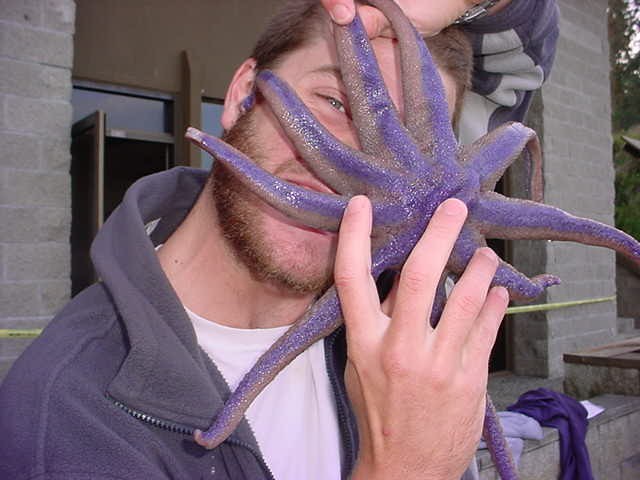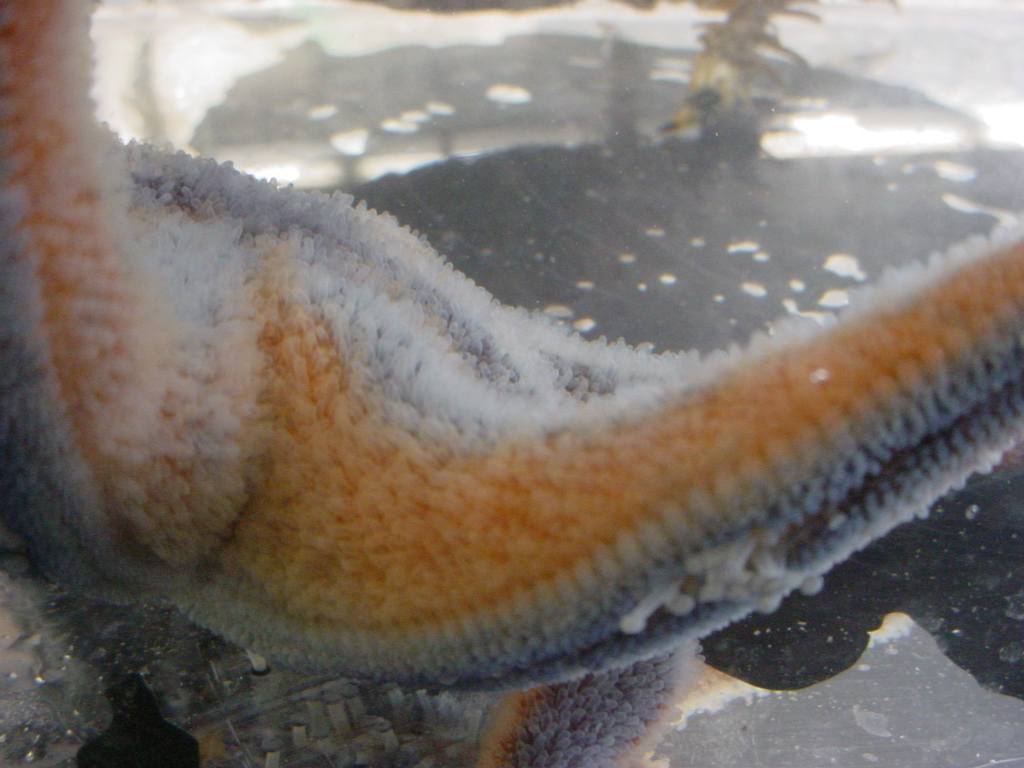Solaster stimpsoni Verrill, 1880Common name(s): Stimpson's sun star, Sun star, Orange sun star |
|
| Synonyms: |  |
| Phylum Echinodermata
Class Asteroidea Order Spinulosida Suborder Eugnathina Family Solasteridae |
|
| Solaster stimpsoni subtidal from Sares Head, WA. | |
| (Photo by: Dave Cowles, 1997) | |
How to Distinguish from Similar Species: Other sun stars have a central disk about 1/3 the total diameter and no prominent dark streaks on the aboral surface. The other most common sun star, S. dawsoni, has an orange, brown, tan, or mottled aboral surface.
Geographical Range: Bering Sea to Salt Point, Sonoma County, CA (not common in California); Japan
Depth Range: Extreme low intertidal to 610 m
Habitat: Mostly rocky subtidal; occasionally on floats and pilings.
Biology/Natural History: Feeds on small sea cucumbers, including Eupentacta quinquesemita, E. pseudoquinquesemita, Cucumaria miniata, C. curata, and Psolus chitonoides. May also eat tunicates such as Pyura haustor, brachiopods, and sea pens. Another common sun star, Solaster dawsoni, is an important predator of this species. May have a commensal polychaete scaleworm Arctonoe pulchra or Arctonie vittata in the ambulacral groove. A parasitic barnacle Dendrogaster sp may be inside the tissues. Eggs are 0.9 to 1 mm diameter, yellow. Juveniles often hide among tubedwelling polychaete Phyllochaetopterus prolifica.
| Return to: | |||
| Main Page | Alphabetic Index | Systematic Index | Glossary |
References:
Dichotomous Keys:Flora and Fairbanks, 1966
Kozloff 1987, 1996
Smith and Carlton, 1975
General References:
Gotshall
and Laurent, 1979
Kozloff,
1993
Morris
et al., 1980
Niesen,
1994
O'Clair
and O'Clair, 1998
Scientific Articles:
Hotchkiss, Frederick C., 2000. On the number of rays in starfish. American Zoologist 40:3 pp. 340-354
Knott, K. Emily, and Gregory A. Wray, 2000. Controversy and consensus
in Asteroid systematics: new insights to Ordinal and Familial
relationships. American Zoologist 40:3 pp. 382-392
McEdward,
Larry R. and Benjamin G. Miner, 2006. Estimation
and interpretation
of egg provisioning in marine invertebrates. Integrative and
Comparative
Biology 46:3 pp 224-232
General Notes and Observations: Locations, abundances, unusual behaviors:

This individual is more blue than usual and appears to be devouring
Robbie Wheeling. Note tape on lab in background--the major
2002 lab
fire had just occurred.

Seasters breathe and rid themselves of wastes via coelomic pouches
or papulae
that they
extrude through their skin when underwater. The extruded
papulae
give them a fuzzy appearance when underwater. Photo of Solaster
stimpsoni by Dave Cowles, Jule 2005.
Authors and Editors of Page:
Dave Cowles (2005): Created original page